|
Meeting Japanese
DXers
by Jim
Solatie
In summer 2001 I had a chance
to visit Tokyo. Besides business, I was honoured
to meet a group of Japanese DXers. We spent one
Saturday evening together discussing our great hobby,
enjoying superb Japanese seafood and - of course
- drinking marvelous sake! Because sake tasted so
good, I wasn't able to write down all the details
we talked about. So after returning home we made
an interview over the Internet with Mr. Hideki Watanabe,
Mr. Tooru Gouhara and Mr. Takashi Kuroda. Please
enjoy their views below!
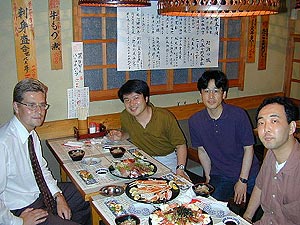 |
| Fresh sushi and sashimi keeps
you on the road. From left Jim Solatie, Masao
Takahashi, Takashi Kuroda and Hideki Watanabe. |
Jim:
Please introduce yourselves.
Hideki:
My name is Hideki Watanabe, 36 years old, single
Japanese. I am working at a company dealing with
health foods in Tokyo. I started listening to shortwave
radio stations back in 1979 and devoted into serious
DXing around 1980. I was mostly listening to Latin
American stations at first but started listening
to medium wave radio stations after I moved to a
town near the coast. I have been targeting Latin
America on the shortwave and North America and South
East Asia on medium wave since then. However, it
is now rather difficult to do MW DXing since I live
in an up-country town at present.
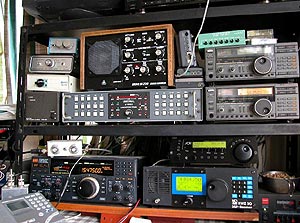 |
| Hideki Watanabe's impressive
range of equipment |
Tooru:
I am Tooru Gouhara and I am 40 years old. I am married
and have two kids (a son and a daughter). I am working
at a company dealing with electronics, electric
parts, plastics, chemical materials, labor-saving
machines and many kinds of assemblies.
Takashi:
My name is Takashi Kuroda, I am 39 years old and
single. I am currently living in Tokyo and working
at international division of a wholesaler and distributor
of candies and snacks. I started SWLing back in
1975 with the Sony ICF-5900. My interest at the
moment is UTE DXing, especially digital modes. I
started UTE DXing back in 1988. In addition to UTE
DXing, I also often attend DX-Camps with my fellow
DXers to listen to mediumwave and shortwave radio
stations in a rural area. My current equipment is
as follows: Receivers: Watkins-Johnson HF-1000A,
Watkins-Johnson HF-1000, Icom R-9000, JRC NRD515
& 545, AOR AR7030Plus, Rohde & Schwartz
EK890. Decorders: Universal M-8000 & M-7000
decoder, Hoka Code30DSP decoder Others: Timewave
DSP-599zx, DX-One Pro antenna with a multiple antenna
distributor.
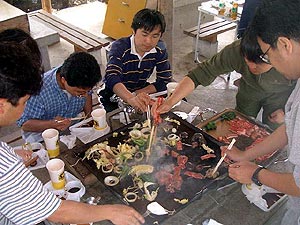 |
| Japanese DXers enjoying good
food on a local dx-meeting |
Jim:
How did you get to know each other?
We were exchanging information
at first on a BBS (Bulletin Board Service) related
to radio hardware at a Japanese computer online
services company called Niftyserve. We made
a first eyeball to eyeball meeting when I visited
Takashi Kuroda in Tokyo who acquired the AOR AR7030
receiver for the first time in Japan from the U.K.
After having met each other, we decided to form
a club that we called AR7030 Ni Hohozuri Suru
Kai which means "a club that likes rubbing
his cheek against the AOR AR7030 receiver".
We have been keeping contact with about 20 members
since then.
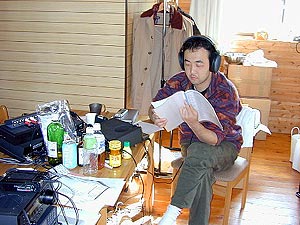 |
| Hideki Watanabe catching new
Philippino stations |
Jim:
What are the main ways you enjoy DXing?
Hideki:
I mainly enjoy catching long distance radio stations
and testing the performance of home brew antennas.
I have tested already Loop, Beverage, Rhombic and
others. I recently begun to like the K9AY antenna.
The directional performance of this antenna is excellent
in my opinion.
Tooru:
Medium wave DXing (the Philippines and Trans Pacific),
collecting QSLs of medium wave and shortwave stations,
collecting second-hand receivers, making a website
on DXing, featuring QSL and other pictures, meeting
with fellow DXers and attending DXpeditions.
Takashi:
I am usually listening to aero frequencies, NAVTEX,
military and diplomatic communications. I also listen
to number stations such as MI6, CIA, or others.
I also enjoy collecting surplus receivers. I used
to own the Racal RA6790GM, RA6793A, RA1792, NRD240
and others.
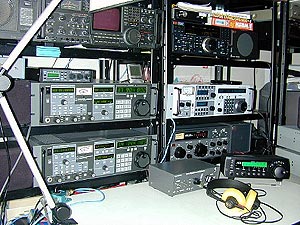 |
|
An experienced DXer needs
professional receivers - this is Takashi Kuroda's
extensive shack
|
Jim:
Which countries or continents are the most interesting
ones to you?
Hideki:
I am especially interested in the Philippine radio
stations. It is because the official frequency list
is available, but it is usually incorrect and you
never know what you hear, which intrigues my curiosity.
Besides, there is always room for new findings.
Tooru:
USA and Canada by Trans-Pacific medium wave DXing.
Radio stations in these regions sometimes give me
responses for my reception reports although it is
written in my broken English.
Takashi:
In the MW DXing, I am interested in North Ameica.
For the UTE DXing, I am interested in Europe as
there are a lot of diplomatic communications.
Jim:
How is the Japanese mediumwave band, is it very
crowded with
local stations or free from interference?
Hideki:
NHK-1 is broadcasting 24 hours a day and also NHK-2
has extended its airtime. Korean stations are also
on the air for 24 hours a day and there are no empty
channels. However, I assume it depends on the region.
For instance, you can still listen to a considerable
number of North American and South American MW stations
in Miyako-City of Iwate Prefecture which is located
about 600 km north of Tokyo. In addition, you can
even listen to the Philippines better than Japanese
local stations in Okinawa Islands which are located
in the south of Japan.
Tooru:
The Japanese medium wave band? It is HELL. There
are too many Japanese, Korean, Chinese and Taiwanese
radio stations on the band. I'm not interested in
these areas and my main interests are Australia,
New Zealand, the Pacific Islands and North America.
I am also interested in mediumwave stations from
Europe and the Middle East.
Takashi:
Since there is a very strong MW transmitter site
near my location, mediumwave DXing at my home is
almost impossible.
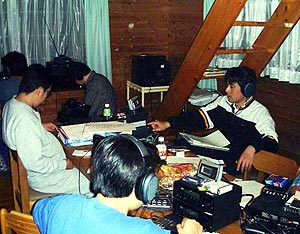 |
| Japanese AM experts on a DXpedition |
Jim:
Can you please tell a little about your dxpeditions?
We usually hold a DX- Camp at
Hasumuma in Chiba Prefecture located east of Tokyo
near the Pacific Ocean. There are lodges facing
the coast and it opens toward North-East to South-West
directions. We usually stay there for 2 nights.
We target Oceania and South East Asia in spring
and North America in autumn. We enjoy DXing by drinking
good beer, as well as rum, wine and spirits, too.
Jim:
How about FM listening? Which countries is it possible
to hear on FM in Japan?
There are conditions to Australia
(TEP propagation), the Philippines, Vietnam, Thailand,
Taiwan, mainland of China, South Korea, Mongolia,
and the Russian Far East (ES). During May to June
season, Chinese and South Korean FM stations are
heard almost everyday here. Also some stations from
Alaska have been heard in Japan!
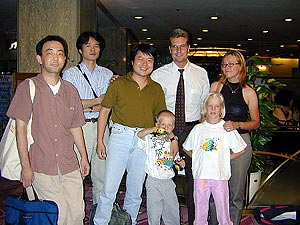 |
| Finnish and Japanese DXers
meeting in Tokyo; from left Hideki Watanabe,
Kenichi Tanaka, Masao Takahashi, Jim Solatie,
Pia Solatie and their kids playing with the
latest Japanese toys. |
Jim:
What are the best local FM and AM stations in Tokyo?
Hideki:
I personally like best J-Wave on 81.3 MHz since
the programs are targeted to adults. I do not listen
to other FM stations as they are usually for young
people. I do not listen to local AM stations as
the programs are boring in my opinion.
Tooru:
At least, ZIP-FM on 77.8 MHz and Radio i on 79.5
MHz are good for me. These stations are located
in central Japan. Radio i is one of the finest FM
stations for foreigners living in Japan. Perhaps
the best Japanese AM station is JOLF on 1242 kHz.
Many young listeners listen to JOLF's midnight programs.
Takashi:
I like J-Wave on 81.3MHZ in Tokyo as it is more
like an American FM radio station with a lot of
music. On AM I listen to NHK-1 for the latest news.
Jim:
What about the future: how are you going to enjoy
DXing in the coming years?
Hideki:
I want to continue enjoying MW DXing at DX Camps
in the coming years.
Tooru:
I am currently busy with making my private website
on DXing.
Takashi:
I will continue UTE DXing. I am also interested
in using PCs with DXing such as controlling radios
and decoders with my notebook or desktop PC.
Jim:
Thanks a lot guys for the interview! We all wish
you great conditions and wonderful moments with
this fabulous hobby.
Published on August
4, 2002. Photos © Jim Solatie 2001.
  
|